Hockey drills for technique passing
- Two solving exercises that you can both do for 10 minutes
- Also first the explanation of the tip-in exercise
- B starts running around the pilons and accelerates when he reaches the goal towards A.
- A gives a hard facing pass towards the goal
- B tip the ball so that it changes direction
- Then they change places
- Other exercise
- We are going to practice walking in out
- A is a right behind who wants to play the ball somewhere. B is the middle right and he is going to run one in out.
- He starts in the middle of the field and wants to offer himself for A.
- He accelerates towards the sideline A may choose whether he wants to give the ball or not.
- If he doesn't give the ball, A finishes his line further and comes back to where he started and then runs again on another in-out.
- If A passes, B takes the ball and is allowed to score on the goaltender.
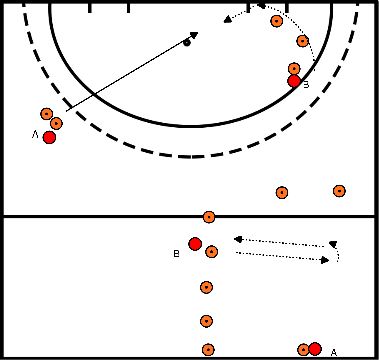
- Exercise expand on both sides
- A gives a push to B
- B takes the ball closed because defender D is in his back.
- B accelerates dribbling with the ball on the stick along the pilons, D runs with B because he doesn't want B to go along.
- D may try to conquer the ball when B has passed the pilons.
- B wants to pass the ball to C. If D intercepts, he passes the ball to C so that the person can continue with the exercise.
- If B gets the ball to C, C will do the same and the defender E will defend. If E picks up the ball, he can finish at the goal.
- How to continue, A goes to the spot of B, B goes to the spot of D, D goes to the spot of C, C goes to the spot of E and E goes to the spot of A.
- Tips for the attackers
- Keep the ball close to you and screen it with your stick
- Pass the ball over the backhand side of your opponent
- Accelerate to make it harder for the defender to stop you
- Tips for the defenders
- Keep your stick on the ground, you can react much faster to what your opponent is doing
- Keep your opponent on the forehand and make sure the line is closed!
- Let the attacker make the mistake and then grab the pass.
- Guide your opponent in the direction where you want him/her to go
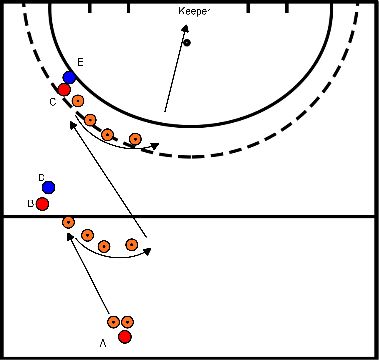
- Exercise expand on both sides.
- A and B start running at the same time,
- A dribbles with the ball on the stick around the pilon.
- B runs in and asks A for the ball.
- A makes eye contact and pushes the ball to B
- B controls the ball closed
- Then dribbles the bars and do two elevator actions over the bars
- Aligns the ball and finishes with a hit on goal.
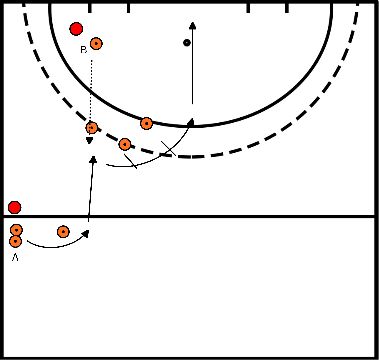
- Players outside the box should replay as often as possible.
- The pass must always pass through the box.
- The players inside the box must try to intercept the ball.
- As soon as the players inside the box have intercepted the ball, they should replay as often as possible inside the box.
- Each time they have replayed 3 times, someone outside the box may enter the box to recapture the ball.
- As soon as they succeed, they will play to someone outside the box and it will start over again, so at least one player must always remain outside the box to be able to play.
- The field can be larger or smaller, there can be more or less players inside and outside the box.
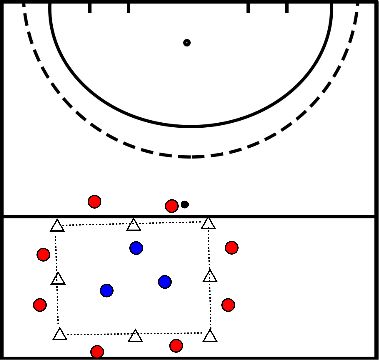
- Player 1 runs with the ball to the white pilon, player 2 runs without the ball to the white pilon.
- Player 2 rounds off on goal (with backhand).
- Player 1 runs around the pilon where player 2 started and runs to the center of the circle.
- As soon as player 1 has played the ball to player 2, player 3 may start. Player 3 plays the ball to player 4.
- Player 4 runs around the white pilon and plays the ball (with backhand) to player 1 who has run into the circle.
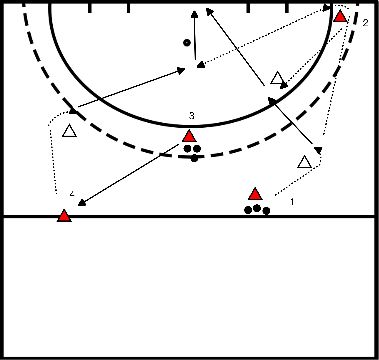
Make 2 teams.
- Both teams have their 'own' course, where they can score points (for example by playing over 5 times in their own course).
- The other team is allowed to conquer the ball in the other box, but not everyone from the other team is allowed to enter the other box.
- The number of players of the other team -1.
- As soon as blue has captured the ball, blue will go to his own square as soon as possible and will play over there as often as possible.
- There may be 3 players of red in the blue box.
- See example: in team red there are 4 players, so 3 players of blue are allowed to enter the red box.
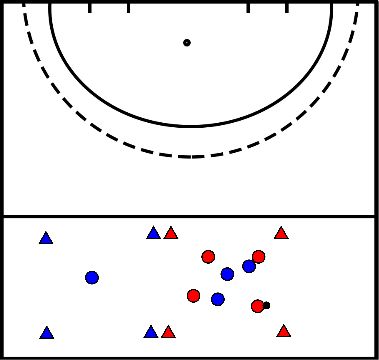
- Goal: to show the player when it is best to pass and when it is best to push.
- In case of a long pass you pass, in case of a short pass you push.
- Player 1 passes (long pass) the ball to player 2
- Player 2 pushes (short pass) the ball to player 3.
- Player 3 passes (long pass) the ball to player 4.
- Player 4 pushes (short pass) the ball to player 5.
- Player 5 passes (long pass) the ball to player 6.
- Player 6 pushes (short pass) the ball to player 7.
- Player 7 runs along the red pilons to the back line and passes (long pass) the ball to player 8, who has entered the circle.
- When explaining the exercise, you can let the player fill in whether it's a long or short pass and what kind of stroke you use, this way they will actively think about it and will apply it earlier in the game.
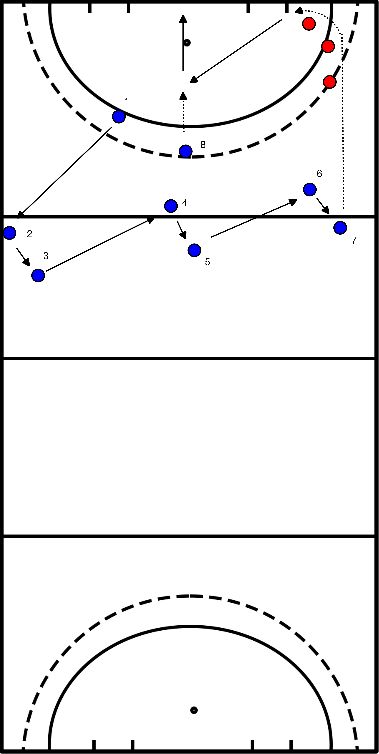
- Make 2 teams.
- From each team place 2 players outside the box opposite each other.
- The ball starts with one of the players outside the box (in the example red).
- As a team you get a point to play from one side to the other, through the players in the box.
- Make the box smaller to make it more difficult or with fewer players.
- Make the box larger to make it easier or with more players.
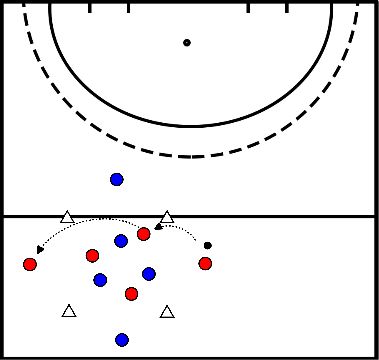
- Ball possession in smaller teams
- Goals is to keep an eye on each other and passing in the forehand of your team mate and passing over the backhand of your opponent.
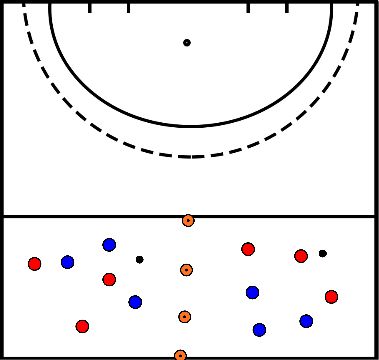
- Exercise with a buildup over right with tip-in variation in it.
- A Wants to play a free ball and there is a lot of pressure at the front. So the ball is played back to B
- B takes the ball while running makes eye contact with the running C which takes the ball and makes eye contact with the running A again.
- A takes the ball open and floats with the ball on the stick at a high speed towards the back line.
- Makes eye contact with the passed C and gives a 90 degree pass in advance.
- C takes the ball and lines the ball up and round with a hit on goal, A stands there active to tip the ball if necessary.
- Next to C, A is immediately ready for the tip of the ball coming from D.
- D has a hard targeted flats just as if he wants to score. A causes this ball to change direction and go into the goal.
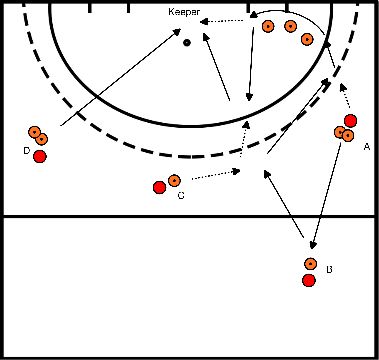
- A pass the ball with a push in the forehand of B
- B takes the ball open and passes the ball to C
- C takes the ball open and passes the ball to D
- D takes the ball open, makes eye contact with E
- E comes running towards the ball and takes the ball while running and turns to the right with the ball on the stick.
- E makes eye contact with F
- F runs into the ball and gets the ball from E who gives a hard push in the forehand
- F takes the ball in the barrel turning to the left and dribbles with the ball on the stick into the circle and aligns the ball or strikes goal.
- G can be added later in the exercise if the exercise goes well
- This runs before the tip-in of F
- This runs before the tip-in of F
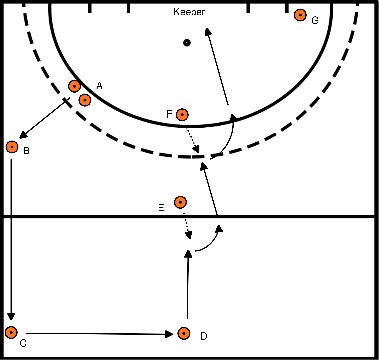
- A starts slaloming through the pilons and does this at speed
- At the end he is told whether he left or right along the pilons and accelerated with the ball on the stick
- A aligns the ball and strikes goal
- He turns around and gets a ball from B on the forehand. he takes the ball, aligns the ball up and around again.
- Turn around immediately and you get a ball of C that you take, line up and complete
- We are running from
- A to C
- C to B
- B to A








